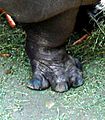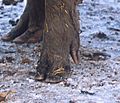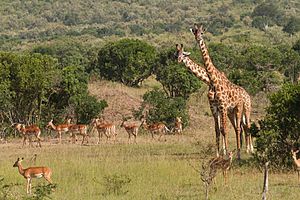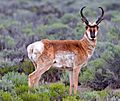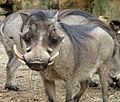Cetartiodactyla facts for kids
Quick facts for kids CetartiodactylsTemporal range: late Palaeocene - Recent
|
|
|---|---|
 |
|
| Scientific classification | |
| Kingdom: | |
| Phylum: | |
| Class: | |
| Infraclass: | |
| Superorder: | |
| (unranked): |
Cetartiodactyla
|
| Orders | |
|
|

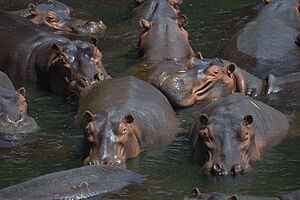
Cetartiodactyla is a big group of mammals. It includes many animals you might know, like pigs, hippos, camels, deer, and even whales and dolphins! They are often called "even-toed ungulates." This is because they usually walk on an even number of toes, like two or four. Their body weight rests equally on their third and fourth toes. This is different from animals like horses, which walk mostly on their middle toe.
Whales, dolphins, and porpoises (called cetaceans) actually evolved from these even-toed animals. Because of this, scientists sometimes group the even-toed ungulates and cetaceans together. This combined group is called Cetartiodactyla.
There are about 220 different kinds of even-toed ungulates. They include pigs, peccaries, hippopotamuses, whales, camels, llamas, alpacas, mouse deer, deer, giraffes, antelopes, sheep, goats, and cattle. Many of these animals are very important to humans for food, farming, and culture.
Contents
Amazing Animal Bodies
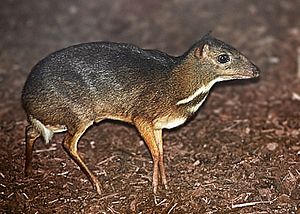
Most even-toed ungulates walk on four legs. There are two main body types in this group. Some, like pigs and hippos, have a strong, heavy body, short legs, and a large head. Others, like camels and animals that chew their cud (ruminants), are more slender with long, thin legs.
Their size can be very different! The smallest is the mouse deer. It is only about 45 centimeters (18 inches) long and weighs about 1.5 kilograms (3.3 pounds). The largest is the hippopotamus. It can grow up to 5 meters (16 feet) long and weigh 4.5 metric tons (9,900 pounds). The giraffe is the tallest, reaching 5.5 meters (18 feet) tall.
Most even-toed ungulates show "sexual dimorphism." This means males and females look a bit different. Males are usually larger and heavier than females. For example, only male deer have antlers. The horns of cattle-like animals are often smaller or missing in females. Male Indian antelopes have much darker fur than females.
Almost all even-toed ungulates have fur. The main exception is the hippopotamus, which has very little hair. Their fur can be different lengths and colors depending on where they live. Animals in colder places might shed their coats. Their fur often helps them blend in, with colors like yellow, gray, brown, or black.
Legs and Toes
Even-toed ungulates get their name because they have an even number of toes. Most have two or four toes. Some peccaries, though, have only three toes on their back legs. The main part of their leg is between the third and fourth toe. The first toe is missing in modern animals of this group.
The second and fifth toes are different for different species. In hippos, these toes point forward and are fully used. For other even-toed ungulates, they might point backward or be very small. For pigs and deer, these extra toes can touch soft, muddy ground. This helps them spread their weight and not sink. However, in most cases, these toes do not touch the ground at all. In some groups, like camels and giraffes, these toes are completely gone.
Camels have only two toes. Their claws have changed into flat nails. Claws are curved and pointed, while nails are flat. These nails have three parts: the top and sides, the bottom, and the back. Generally, the nails on their front feet are wider than those on their back feet. Except for camels, all even-toed ungulates walk only on the tips of their front toe bones.
The bones in their upper legs and lower legs are usually long. Their leg muscles are mostly near the body. This gives artiodactyls very slender legs. They do not have a clavicle (collarbone). Their shoulder blade is very flexible. It swings back and forth to help them move faster when running. The special design of their legs means they cannot rotate their legs. This makes them very stable when running fast. Also, many smaller even-toed ungulates have a very flexible body. This helps them run faster by taking longer steps.
Heads and Horns
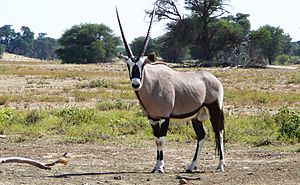
Many even-toed ungulates have a fairly large head. Their skull is long and narrow. The bone at the front of the head (frontal bone) is large at the back. It pushes back the bone on the side of the head (parietal bone).
Horns and Antlers
Four families of even-toed ungulates have special growths on their heads. These are called cranial appendages. They include true horns, antlers, ossicones, or pronghorns.
True horns have a bone inside covered by a hard, permanent layer of keratin. Keratin is the same stuff your fingernails are made of. You find true horns only on bovids, like cattle and goats. Antlers are made of bone and grow each year. They fall off and grow back. Deer have antlers. They grow from a permanent part of the skull called a pedicle. Antlers can be branched, like on a white-tailed deer, or flat and wide, like on a moose.
Ossicones are permanent bone growths that join to the skull bones as the animal grows. Only giraffes have ossicones. Pronghorns are similar to horns because they have a keratin cover over a bone core. But unlike true horns, pronghorns are shed each year, like antlers.
All these head growths help animals show off, fight for mates, and defend themselves. In most cases, only the males have them.
Senses
Even-toed ungulates have a very good sense of smell and hearing. But unlike many other mammals, their eyesight is not as strong. They can see moving things much better than still objects. Like many animals that are hunted, their eyes are on the sides of their head. This gives them a wide view, helping them spot danger from almost all directions.
How They Live
Where They Live
Even-toed ungulates live in almost every part of the world. The only places they are not naturally found are Oceania (like Australia) and Antarctica. However, humans have brought different kinds of these animals to new places for hunting.
They live in almost every type of environment. You can find them in rain forests, dry steppes, hot deserts, and high mountain regions. The most different kinds of even-toed ungulates live in open areas like grasslands and open forests.
Living Together
How even-toed ungulates live together changes from one species to another. Many tend to live in larger groups. But some live alone or in pairs. Species that live in groups often have a "social hierarchy." This means there is a pecking order among both males and females.
Some species live in "harem groups." This is where one male lives with several females and their young. In other species, the females and young stay together. The males live alone or in groups of other males. They only join the females during the mating season.
Images for kids
-
Richard Owen coined the term "even-toed ungulate".
-
The mesonychids were long considered ancestors of whales.
-
Camels are now considered a sister group of Artiofabula.
-
The pronghorn is the only extant antilocaprid.
-
Reconstruction of Indohyus
-
Blue duiker (Philantomba monticola) skeleton on display at the Museum of Osteology.
-
The Japanese serow has glands in the eyes that are clearly visible.
-
Most artiodactyls, such as the wildebeest, are born with hair.
-
Some artiodactyls, like sheep, have been domesticated for thousands of years.
-
The aurochs has been extinct since the 17th century.
See also
 In Spanish: Artiodáctilos para niños
In Spanish: Artiodáctilos para niños


